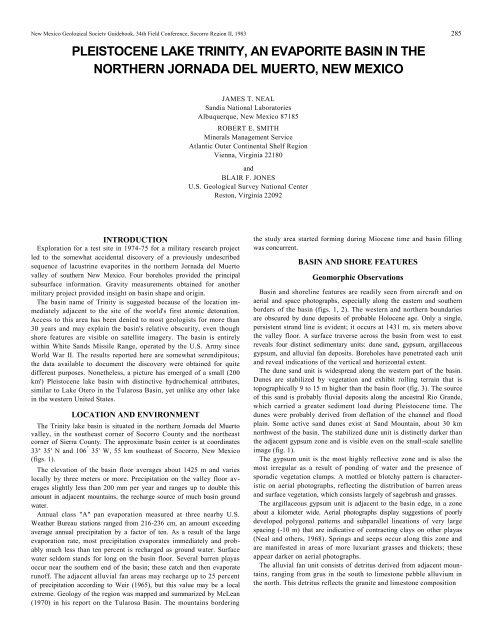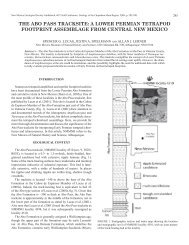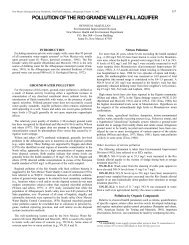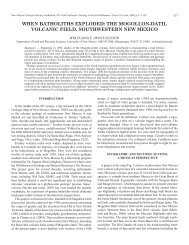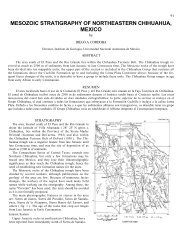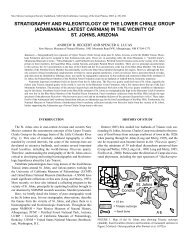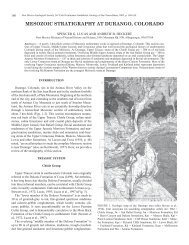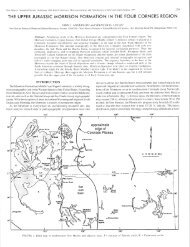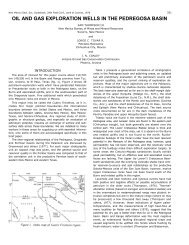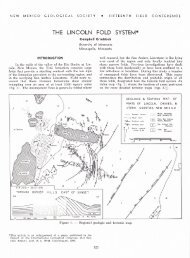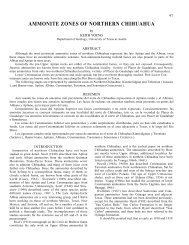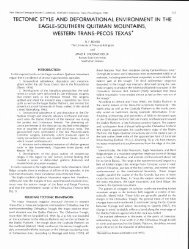Pleistocene Lake Trinity, an evaporite basin in the - New Mexico ...
Pleistocene Lake Trinity, an evaporite basin in the - New Mexico ...
Pleistocene Lake Trinity, an evaporite basin in the - New Mexico ...
Create successful ePaper yourself
Turn your PDF publications into a flip-book with our unique Google optimized e-Paper software.
<strong>New</strong> <strong>Mexico</strong> Geological Society Guidebook, 34th Field Conference, Socorro Region II, 1983 285<br />
PLEISTOCENE LAKE TRINITY, AN EVAPORITE BASIN IN THE<br />
NORTHERN JORNADA DEL MUERTO, NEW MEXICO<br />
INTRODUCTION<br />
Exploration for a test site <strong>in</strong> 1974-75 for a military research project<br />
led to <strong>the</strong> somewhat accidental discovery of a previously undescribed<br />
sequence of lacustr<strong>in</strong>e <strong>evaporite</strong>s <strong>in</strong> <strong>the</strong> nor<strong>the</strong>rn Jornada del Muerto<br />
valley of sou<strong>the</strong>rn <strong>New</strong> <strong>Mexico</strong>. Four boreholes provided <strong>the</strong> pr<strong>in</strong>cipal<br />
subsurface <strong>in</strong>formation. Gravity measurements obta<strong>in</strong>ed for <strong>an</strong>o<strong>the</strong>r<br />
military project provided <strong>in</strong>sight on <strong>bas<strong>in</strong></strong> shape <strong>an</strong>d orig<strong>in</strong>.<br />
The <strong>bas<strong>in</strong></strong> name of <strong>Tr<strong>in</strong>ity</strong> is suggested because of <strong>the</strong> location immediately<br />
adjacent to <strong>the</strong> site of <strong>the</strong> world's first atomic detonation.<br />
Access to this area has been denied to most geologists for more th<strong>an</strong><br />
30 years <strong>an</strong>d may expla<strong>in</strong> <strong>the</strong> <strong>bas<strong>in</strong></strong>'s relative obscurity, even though<br />
shore features are visible on satellite imagery. The <strong>bas<strong>in</strong></strong> is entirely<br />
with<strong>in</strong> White S<strong>an</strong>ds Missile R<strong>an</strong>ge, operated by <strong>the</strong> U.S. Army s<strong>in</strong>ce<br />
World War II. The results reported here are somewhat serendipitous;<br />
<strong>the</strong> data available to document <strong>the</strong> discovery were obta<strong>in</strong>ed for quite<br />
different purposes. None<strong>the</strong>less, a picture has emerged of a small (200<br />
km') <strong>Pleistocene</strong> lake <strong>bas<strong>in</strong></strong> with dist<strong>in</strong>ctive hydrochemical attributes,<br />
similar to <strong>Lake</strong> Otero <strong>in</strong> <strong>the</strong> Tularosa Bas<strong>in</strong>, yet unlike <strong>an</strong>y o<strong>the</strong>r lake<br />
<strong>in</strong> <strong>the</strong> western United States.<br />
LOCATION AND ENVIRONMENT<br />
The <strong>Tr<strong>in</strong>ity</strong> lake <strong>bas<strong>in</strong></strong> is situated <strong>in</strong> <strong>the</strong> nor<strong>the</strong>rn Jornada del Muerto<br />
valley, <strong>in</strong> <strong>the</strong> sou<strong>the</strong>ast corner of Socorro County <strong>an</strong>d <strong>the</strong> nor<strong>the</strong>ast<br />
corner of Sierra County. The approximate <strong>bas<strong>in</strong></strong> center is at coord<strong>in</strong>ates<br />
33° 35' N <strong>an</strong>d 106 ° 35' W, 55 km sou<strong>the</strong>ast of Socorro, <strong>New</strong> <strong>Mexico</strong><br />
(figs. 1).<br />
The elevation of <strong>the</strong> <strong>bas<strong>in</strong></strong> floor averages about 1425 m <strong>an</strong>d varies<br />
locally by three meters or more. Precipitation on <strong>the</strong> valley floor averages<br />
slightly less th<strong>an</strong> 200 mm per year <strong>an</strong>d r<strong>an</strong>ges up to double this<br />
amount <strong>in</strong> adjacent mounta<strong>in</strong>s, <strong>the</strong> recharge source of much <strong>bas<strong>in</strong></strong> ground<br />
water.<br />
Annual class "A" p<strong>an</strong> evaporation measured at three nearby U.S.<br />
Wea<strong>the</strong>r Bureau stations r<strong>an</strong>ged from 216-236 cm, <strong>an</strong> amount exceed<strong>in</strong>g<br />
average <strong>an</strong>nual precipitation by a factor of ten. As a result of <strong>the</strong> large<br />
evaporation rate, most precipitation evaporates immediately <strong>an</strong>d probably<br />
much less th<strong>an</strong> ten percent is recharged as ground water. Surface<br />
water seldom st<strong>an</strong>ds for long on <strong>the</strong> <strong>bas<strong>in</strong></strong> floor. Several barren playas<br />
occur near <strong>the</strong> sou<strong>the</strong>rn end of <strong>the</strong> <strong>bas<strong>in</strong></strong>; <strong>the</strong>se catch <strong>an</strong>d <strong>the</strong>n evaporate<br />
runoff. The adjacent alluvial f<strong>an</strong> areas may recharge up to 25 percent<br />
of precipitation accord<strong>in</strong>g to Weir (1965), but this value may be a local<br />
extreme. Geology of <strong>the</strong> region was mapped <strong>an</strong>d summarized by McLe<strong>an</strong><br />
(1970) <strong>in</strong> his report on <strong>the</strong> Tularosa Bas<strong>in</strong>. The mounta<strong>in</strong>s border<strong>in</strong>g<br />
JAMES T. NEAL<br />
S<strong>an</strong>dia National Laboratories<br />
Albuquerque, <strong>New</strong> <strong>Mexico</strong> 87185<br />
ROBERT E. SMITH<br />
M<strong>in</strong>erals M<strong>an</strong>agement Service<br />
Atl<strong>an</strong>tic Outer Cont<strong>in</strong>ental Shelf Region<br />
Vienna, Virg<strong>in</strong>ia 22180<br />
<strong>an</strong>d<br />
BLAIR F. JONES<br />
U.S. Geological Survey National Center<br />
Reston, Virg<strong>in</strong>ia 22092<br />
<strong>the</strong> study area started form<strong>in</strong>g dur<strong>in</strong>g Miocene time <strong>an</strong>d <strong>bas<strong>in</strong></strong> fill<strong>in</strong>g<br />
was concurrent.<br />
BASIN AND SHORE FEATURES<br />
Geomorphic Observations<br />
Bas<strong>in</strong> <strong>an</strong>d shorel<strong>in</strong>e features are readily seen from aircraft <strong>an</strong>d on<br />
aerial <strong>an</strong>d space photographs, especially along <strong>the</strong> eastern <strong>an</strong>d sou<strong>the</strong>rn<br />
borders of <strong>the</strong> <strong>bas<strong>in</strong></strong> (figs. 1, 2). The western <strong>an</strong>d nor<strong>the</strong>rn boundaries<br />
are obscured by dune deposits of probable Holocene age. Only a s<strong>in</strong>gle,<br />
persistent str<strong>an</strong>d l<strong>in</strong>e is evident; it occurs at 1431 m, six meters above<br />
<strong>the</strong> valley floor. A surface traverse across <strong>the</strong> <strong>bas<strong>in</strong></strong> from west to east<br />
reveals four dist<strong>in</strong>ct sedimentary units: dune s<strong>an</strong>d, gypsum, argillaceous<br />
gypsum, <strong>an</strong>d alluvial f<strong>an</strong> deposits. Boreholes have penetrated each unit<br />
<strong>an</strong>d reveal <strong>in</strong>dications of <strong>the</strong> vertical <strong>an</strong>d horizontal extent.<br />
The dune s<strong>an</strong>d unit is widespread along <strong>the</strong> western part of <strong>the</strong> <strong>bas<strong>in</strong></strong>.<br />
Dunes are stabilized by vegetation <strong>an</strong>d exhibit roll<strong>in</strong>g terra<strong>in</strong> that is<br />
topographically 9 to 15 m higher th<strong>an</strong> <strong>the</strong> <strong>bas<strong>in</strong></strong> floor (fig. 3). The source<br />
of this s<strong>an</strong>d is probably fluvial deposits along <strong>the</strong> <strong>an</strong>cestral Rio Gr<strong>an</strong>de,<br />
which carried a greater sediment load dur<strong>in</strong>g <strong>Pleistocene</strong> time. The<br />
dunes were probably derived from deflation of <strong>the</strong> ch<strong>an</strong>nel <strong>an</strong>d flood<br />
pla<strong>in</strong>. Some active s<strong>an</strong>d dunes exist at S<strong>an</strong>d Mounta<strong>in</strong>, about 30 km<br />
northwest of <strong>the</strong> <strong>bas<strong>in</strong></strong>. The stabilized dune unit is dist<strong>in</strong>ctly darker th<strong>an</strong><br />
<strong>the</strong> adjacent gypsum zone <strong>an</strong>d is visible even on <strong>the</strong> small-scale satellite<br />
image (fig. 1).<br />
The gypsum unit is <strong>the</strong> most highly reflective zone <strong>an</strong>d is also <strong>the</strong><br />
most irregular as a result of pond<strong>in</strong>g of water <strong>an</strong>d <strong>the</strong> presence of<br />
sporadic vegetation clumps. A mottled or blotchy pattern is characteristic<br />
on aerial photographs, reflect<strong>in</strong>g <strong>the</strong> distribution of barren areas<br />
<strong>an</strong>d surface vegetation, which consists largely of sagebrush <strong>an</strong>d grasses.<br />
The argillaceous gypsum unit is adjacent to <strong>the</strong> <strong>bas<strong>in</strong></strong> edge, <strong>in</strong> a zone<br />
about a kilometer wide. Aerial photographs display suggestions of poorly<br />
developed polygonal patterns <strong>an</strong>d subparallel l<strong>in</strong>eations of very large<br />
spac<strong>in</strong>g (-10 m) that are <strong>in</strong>dicative of contract<strong>in</strong>g clays on o<strong>the</strong>r playas<br />
(Neal <strong>an</strong>d o<strong>the</strong>rs, 1968). Spr<strong>in</strong>gs <strong>an</strong>d seeps occur along this zone <strong>an</strong>d<br />
are m<strong>an</strong>ifested <strong>in</strong> areas of more luxuri<strong>an</strong>t grasses <strong>an</strong>d thickets; <strong>the</strong>se<br />
appear darker on aerial photographs.<br />
The alluvial f<strong>an</strong> unit consists of detritus derived from adjacent mounta<strong>in</strong>s,<br />
r<strong>an</strong>g<strong>in</strong>g from grus <strong>in</strong> <strong>the</strong> south to limestone pebble alluvium <strong>in</strong><br />
<strong>the</strong> north. This detritus reflects <strong>the</strong> gr<strong>an</strong>ite <strong>an</strong>d limestone composition
of <strong>the</strong> adjacent mounta<strong>in</strong>s. The alluvial f<strong>an</strong>s appear dark on aerial<br />
photographs <strong>an</strong>d are ch<strong>an</strong>neled normal to <strong>the</strong> shore contours (fig. 2).<br />
The contrast between <strong>the</strong> <strong>bas<strong>in</strong></strong> <strong>an</strong>d f<strong>an</strong> units is conspicuous on <strong>the</strong><br />
satellite image (fig. 1).<br />
Geophysical Measurements<br />
Seismic reflection <strong>an</strong>d refraction surveys, regional (<strong>bas<strong>in</strong></strong>) gravity<br />
profil<strong>in</strong>g, <strong>an</strong>d <strong>an</strong> aeromagnetic survey were performed <strong>in</strong> <strong>the</strong><br />
vic<strong>in</strong>ity of <strong>the</strong> <strong>Tr<strong>in</strong>ity</strong> lake <strong>bas<strong>in</strong></strong>; each has provided some <strong>in</strong>formation on<br />
<strong>bas<strong>in</strong></strong> configuration.<br />
Gravity observations were made by Healey <strong>an</strong>d o<strong>the</strong>rs (1978) <strong>in</strong><br />
portions of <strong>the</strong> Tularosa Bas<strong>in</strong> <strong>an</strong>d <strong>the</strong> Jornada del Muerto valley. The<br />
contoured gravity map <strong>an</strong>d a bedrock-to-bedrock tr<strong>an</strong>sect across <strong>the</strong><br />
<strong>bas<strong>in</strong></strong> showed a partial co<strong>in</strong>cidence of <strong>the</strong> lake <strong>bas<strong>in</strong></strong> with <strong>the</strong> gravity<br />
<strong>bas<strong>in</strong></strong>, although <strong>the</strong> latter, a major low, is centered about 20 km to <strong>the</strong><br />
north. Gravity gradients are steepest along <strong>the</strong> eastern marg<strong>in</strong>s of <strong>the</strong><br />
<strong>bas<strong>in</strong></strong>, probably <strong>in</strong>dicat<strong>in</strong>g that major faults with<strong>in</strong> <strong>the</strong> Rio Gr<strong>an</strong>de rift<br />
form <strong>the</strong> eastern marg<strong>in</strong> of <strong>the</strong> <strong>bas<strong>in</strong></strong>. The eastern marg<strong>in</strong> of <strong>the</strong> lake<br />
<strong>bas<strong>in</strong></strong> co<strong>in</strong>cides with <strong>the</strong> axis of <strong>the</strong> gravity trough. A l<strong>in</strong>eation on space<br />
imagery (fig. 1) may be <strong>the</strong> surface m<strong>an</strong>ifestation of <strong>the</strong>se faults. The<br />
l<strong>in</strong>eation cross<strong>in</strong>g <strong>the</strong> sou<strong>the</strong>rn portion of <strong>the</strong> <strong>bas<strong>in</strong></strong> was <strong>in</strong>terpreted<br />
as a small graben by a seismic reflection profile (Neal, 1976).<br />
However, <strong>the</strong> few gravity observations allow only a broad,<br />
generalized contour<strong>in</strong>g of <strong>the</strong> gravity values. The measured gravity<br />
<strong>an</strong>omalies are consistent with <strong>the</strong> thickness of Tertiary <strong>bas<strong>in</strong></strong> fill <strong>in</strong>ferred<br />
from seismic reflection sound<strong>in</strong>g.
PLEISTOCENE LAKE TRINITY 287<br />
STRATIGRAPHY<br />
Borehole Data<br />
Four exploratory bor<strong>in</strong>gs (fig. 4) provide <strong>the</strong> subsurface data needed<br />
to plot a <strong>bas<strong>in</strong></strong> profile (fig. 5). Holes C <strong>an</strong>d D were drilled first, us<strong>in</strong>g<br />
rotary methods; samples were collected from cutt<strong>in</strong>gs recovered from<br />
<strong>the</strong> drill<strong>in</strong>g fluid. Attempts were made to obta<strong>in</strong> material as pure as<br />
possible from each depth sampled. Holes A <strong>an</strong>d B were also drilled by<br />
rotary methods, but a Dennison tube provided undisturbed cores. Consequently<br />
<strong>the</strong>se latter samples are more reliable for m<strong>in</strong>eralogic studies.<br />
The stratigraphic correlation (fig. 5) is based on <strong>an</strong> evaluation of <strong>the</strong><br />
unconsolidated sedimentary sequence penetrated <strong>in</strong> <strong>the</strong> boreholes <strong>an</strong>d<br />
on geological <strong>an</strong>d m<strong>in</strong>eralogical data.<br />
Sedimentary Units<br />
The S<strong>an</strong>ta Fe Group (Tertiary) underlies <strong>the</strong> younger <strong>bas<strong>in</strong></strong> deposits.<br />
The S<strong>an</strong>ta Fe Group is not well def<strong>in</strong>ed <strong>in</strong> this area because outcrop<br />
exposures are poor <strong>an</strong>d subsurface control is lack<strong>in</strong>g (Weir, 1965). Even<br />
<strong>the</strong> deepest borehole (B) only reached a depth of 39.6 m <strong>in</strong> <strong>the</strong> <strong>bas<strong>in</strong></strong><br />
center, <strong>an</strong>d did not penetrate <strong>the</strong> S<strong>an</strong>ta Fe Group. The upper surface of<br />
<strong>the</strong> S<strong>an</strong>ta Fe Group probably grades <strong>in</strong>to <strong>the</strong> <strong>Pleistocene</strong> alluvium because<br />
both units consist of silt, s<strong>an</strong>d, <strong>an</strong>d gravel wea<strong>the</strong>red from <strong>the</strong><br />
adjacent mounta<strong>in</strong>s.<br />
Borehole data <strong>an</strong>d <strong>the</strong> <strong>bas<strong>in</strong></strong> profile (figs. 4, 5) show alternat<strong>in</strong>g s<strong>an</strong>d<br />
<strong>an</strong>d clay of variable thickness; <strong>the</strong> depositional orig<strong>in</strong> is uncerta<strong>in</strong> but<br />
may reflect alternat<strong>in</strong>g fluviatile <strong>an</strong>d lacustr<strong>in</strong>e conditions. The s<strong>an</strong>d<br />
strata of <strong>the</strong> lower portion of <strong>the</strong>se deposits appears to th<strong>in</strong> eastward<br />
where it grades <strong>in</strong>to, <strong>an</strong>d <strong>in</strong>terf<strong>in</strong>gers with, alluvial-f<strong>an</strong> gravels. Borehole<br />
samples showed gradational contacts between <strong>the</strong>se alternat<strong>in</strong>g<br />
s<strong>an</strong>d <strong>an</strong>d clay units.<br />
Above <strong>the</strong> thick s<strong>an</strong>d layer is a clay zone that th<strong>in</strong>s toward <strong>the</strong> <strong>bas<strong>in</strong></strong><br />
center. The clay is gypsiferous at <strong>bas<strong>in</strong></strong> center, but is less gypsiferous<br />
<strong>an</strong>d more silty or s<strong>an</strong>dy under <strong>the</strong> alluvial f<strong>an</strong> at borehole D. With<strong>in</strong><br />
<strong>the</strong> massive gypsiferous clay zone <strong>in</strong> borehole A, a th<strong>in</strong> layer of pure<br />
gypsum fragments, which probably formed by precipitation <strong>in</strong> <strong>an</strong> isolated<br />
pond, occurs at 18.3 m depth. A 3-m s<strong>an</strong>d bed occurs higher <strong>in</strong><br />
<strong>the</strong> dom<strong>in</strong><strong>an</strong>tly clay sequence, above <strong>the</strong> massive gypsum zone.<br />
F<strong>in</strong>e-gra<strong>in</strong>ed, nearly pure gypsum characterizes <strong>the</strong> most dist<strong>in</strong>ctive<br />
sediment zone <strong>in</strong> <strong>the</strong> <strong>bas<strong>in</strong></strong> center. This irregular sulfate body overlies<br />
<strong>an</strong>d <strong>in</strong>terf<strong>in</strong>gers with clay at its east <strong>an</strong>d west marg<strong>in</strong>s. A 0.5-m-thick<br />
layer of tr<strong>an</strong>slucent hexahydrite occurs at a depth of approximately 19
m with<strong>in</strong> <strong>the</strong> gypsum facies <strong>in</strong> borehole B. It was probably formed by<br />
precipitation from solutions reach<strong>in</strong>g saturation <strong>in</strong> magnesium sulfate.<br />
The hydrochemical implications of this sulfate zone will be discussed<br />
later.<br />
At <strong>the</strong> western <strong>bas<strong>in</strong></strong> marg<strong>in</strong>, quartz dune s<strong>an</strong>ds cover part of <strong>the</strong><br />
surface of <strong>the</strong> massive gypsum zone. The contact at depth between <strong>the</strong><br />
widespread dune s<strong>an</strong>d <strong>an</strong>d gypsum <strong>in</strong> borehole A is tr<strong>an</strong>sitional with a<br />
gradual ch<strong>an</strong>ge <strong>in</strong> gypsum content. The gypsum crystals <strong>in</strong> <strong>the</strong> s<strong>an</strong>d<br />
probably reflect secondary dissolution of gypsum <strong>an</strong>d precipitation <strong>in</strong><br />
place, so as to partially cement <strong>the</strong> s<strong>an</strong>d. Stratigraphically, <strong>the</strong> dune<br />
s<strong>an</strong>d is <strong>the</strong> youngest deposit <strong>in</strong> <strong>the</strong> <strong>bas<strong>in</strong></strong>.<br />
The alluvial f<strong>an</strong>s are <strong>the</strong> topographically highest deposits (but not<br />
necessarily <strong>the</strong> youngest). Much of this sediment is s<strong>an</strong>d <strong>an</strong>d gravel<br />
that th<strong>in</strong>s abruptly at <strong>the</strong> contact with <strong>the</strong> sulfate body. Clast compositions<br />
reflect <strong>the</strong> gr<strong>an</strong>itic <strong>an</strong>d limestone bedrock of <strong>the</strong> adjacent mounta<strong>in</strong>s.<br />
MINERALOGY<br />
Forty-one samples were <strong>an</strong>alyzed from boreholes A, B, <strong>an</strong>d C at<br />
depths r<strong>an</strong>g<strong>in</strong>g from 0.5 to 37.2 m (fig. 4). The first observations<br />
revealed that gypsum was dispersed <strong>in</strong> vary<strong>in</strong>g proportions throughout<br />
<strong>the</strong> material. Samples from borehole D on <strong>the</strong> eastern alluvial f<strong>an</strong> were<br />
not available for <strong>an</strong>alysis but <strong>the</strong> field log was correlated with adjacent<br />
borehole C. Because of <strong>the</strong> highly dispersed nature of gypsum present<br />
<strong>in</strong> boreholes A, B, <strong>an</strong>d C, three complementary methods were used to<br />
determ<strong>in</strong>e m<strong>in</strong>eral composition <strong>an</strong>d amount: x-ray diffraction, petrographic<br />
<strong>an</strong>alysis, <strong>an</strong>d chemical dissolution (for separation of solubles<br />
<strong>an</strong>d <strong>in</strong>solubles).<br />
X-ray diffraction was used to verify overall m<strong>in</strong>eralogic composition<br />
of f<strong>in</strong>e to coarse lake sediment <strong>an</strong>d m<strong>in</strong>eral distribution. Additional<br />
material from <strong>the</strong> samples was selected by siev<strong>in</strong>g a 37 p.m ( — 400 mesh) portion<br />
for <strong>the</strong> 75-150 )m6 fraction. Selected samples of <strong>the</strong>se fractions were<br />
also x-rayed to determ<strong>in</strong>e m<strong>in</strong>eral composition.<br />
Much of <strong>the</strong> 75-1501.1m fraction (f<strong>in</strong>e s<strong>an</strong>d) was used for petrographic<br />
<strong>an</strong>alysis to obta<strong>in</strong> a m<strong>in</strong>eral distribution of <strong>the</strong> <strong>bas<strong>in</strong></strong>. The method <strong>in</strong>volved<br />
mount<strong>in</strong>g <strong>the</strong> material <strong>in</strong> <strong>in</strong>dex oils under cover glasses <strong>an</strong>d<br />
mak<strong>in</strong>g po<strong>in</strong>t counts (Table 1). The petrographic study was especially<br />
useful <strong>in</strong> identify<strong>in</strong>g m<strong>in</strong>or m<strong>in</strong>erals that could not be identified by x-<br />
ray diffraction. M<strong>an</strong>y of <strong>the</strong>se procedures were adopted from a previous<br />
study of a playa lake by Deike <strong>an</strong>d Jones (1980).<br />
Leach<strong>in</strong>g of soluble m<strong>in</strong>erals by distilled water failed to produce<br />
acceptable results <strong>an</strong>d gypsum peaks dom<strong>in</strong>ated <strong>the</strong> x-ray patterns,<br />
sometimes suppress<strong>in</strong>g diffraction of import<strong>an</strong>t silicate m<strong>in</strong>erals. It was<br />
necessary to use chemical procedures that would elim<strong>in</strong>ate soluble m<strong>in</strong>erals<br />
<strong>an</strong>d gypsum without destroy<strong>in</strong>g silicates.<br />
An effective dissolution agent for sulfates <strong>an</strong>d carbonates is EDTA<br />
(ethyld<strong>in</strong>itriotetracetic acid) with <strong>the</strong> pH properly set between 10 <strong>an</strong>d<br />
12. This technique was adapted from Bod<strong>in</strong>e <strong>an</strong>d Fernald (1973). Results<br />
were quite satisfactory; reproducibility of a s<strong>in</strong>gle sample <strong>an</strong>alyzed<br />
six times r<strong>an</strong>ged between 0.3 <strong>an</strong>d 0.8 weight percent. The procedure<br />
was also helpful <strong>in</strong> del<strong>in</strong>eat<strong>in</strong>g <strong>the</strong> sulfate zone.<br />
The comb<strong>in</strong>ation of all <strong>the</strong> field <strong>an</strong>d laboratory <strong>in</strong>vestigations of<br />
<strong>Tr<strong>in</strong>ity</strong> <strong>bas<strong>in</strong></strong> revealed that <strong>the</strong> most abund<strong>an</strong>t m<strong>in</strong>erals were gypsum,<br />
quartz, clays (smectite <strong>an</strong>d kaol<strong>in</strong>ite), <strong>an</strong>d feldspar, with lesser calcite<br />
<strong>an</strong>d m<strong>in</strong>or amounts of amphiboles, pyroxenes, dolomite, hexahydrite,<br />
<strong>an</strong>d magnesite. Trace amounts of magnetite, hematite, highly wea<strong>the</strong>red<br />
oliv<strong>in</strong>e, <strong>an</strong>d rock fragments that appeared to be igneous detritus were<br />
noted <strong>in</strong> some samples.<br />
Gypsum, <strong>the</strong> most abund<strong>an</strong>t of two sulfates found <strong>in</strong> <strong>the</strong> <strong>bas<strong>in</strong></strong>, is<br />
primarily f<strong>in</strong>e gra<strong>in</strong>ed <strong>an</strong>d massive. Sat<strong>in</strong>spar (parallel, fibrous-look<strong>in</strong>g<br />
fragments) was observed at 18.3 m <strong>in</strong> borehole A. Hexahydrite<br />
(MgSO 4•6H20) was identified <strong>in</strong> a 0.5-m layer at 18.7 m <strong>in</strong> borehole<br />
B only (figs. 4, 6). It is a product of epsomite (MgSO 4•7H20) dehydration<br />
<strong>in</strong> <strong>the</strong> presence of air at ord<strong>in</strong>ary temperatures (Berry <strong>an</strong>d Mason,<br />
1968), but c<strong>an</strong> also result from primary precipitation. This phase may<br />
have formed <strong>in</strong> situ <strong>in</strong> <strong>Lake</strong> <strong>Tr<strong>in</strong>ity</strong> by precipitation from highly sal<strong>in</strong>e,<br />
magnesium-rich solutions accumulat<strong>in</strong>g on <strong>the</strong> playa surface.
PLEISTOCENE LAKE TRINITY 289<br />
Quartz is <strong>the</strong> second most abund<strong>an</strong>t m<strong>in</strong>eral <strong>in</strong> <strong>the</strong> <strong>bas<strong>in</strong></strong> <strong>an</strong>d is <strong>the</strong><br />
pr<strong>in</strong>cipal constituent of <strong>the</strong> clastic facies. As would be expected, <strong>the</strong><br />
<strong>an</strong>alyses show that quartz is most abund<strong>an</strong>t <strong>in</strong> <strong>the</strong> dune s<strong>an</strong>ds on <strong>the</strong><br />
west but is also predom<strong>in</strong><strong>an</strong>t <strong>in</strong> <strong>the</strong> alluvial f<strong>an</strong>s on <strong>the</strong> east, where it<br />
averages about 20 to 28 volume percent. Quartz is relatively m<strong>in</strong>or <strong>in</strong><br />
samples from <strong>the</strong> central sulfate zone, averag<strong>in</strong>g about eight volume<br />
percent. The quartz is detrital <strong>in</strong> all cases.<br />
Clay, like quartz, is abund<strong>an</strong>t <strong>in</strong> <strong>the</strong> <strong>bas<strong>in</strong></strong>, commonly <strong>in</strong> aggregate<br />
particles, with <strong>the</strong> least concentration <strong>in</strong> <strong>the</strong> <strong>bas<strong>in</strong></strong> center <strong>an</strong>d <strong>the</strong> highest<br />
concentration peripheral to <strong>the</strong> massive sulfate facies. M<strong>in</strong>eralogically,<br />
<strong>the</strong> clays are smectite, illite <strong>in</strong>terstratifications <strong>an</strong>d kaol<strong>in</strong>ite.<br />
Feldspars are also common detrital m<strong>in</strong>erals <strong>in</strong> <strong>the</strong> <strong>bas<strong>in</strong></strong>; plagioclase<br />
<strong>an</strong>d orthoclase occur at a ratio of about two to one. Po<strong>in</strong>t counts from<br />
petrographic slides showed <strong>an</strong> even distribution <strong>in</strong> <strong>the</strong> <strong>bas<strong>in</strong></strong>, but x-ray<br />
diffraction data suggested that <strong>the</strong> feldspars are more prevalent <strong>in</strong> <strong>the</strong><br />
<strong>bas<strong>in</strong></strong> center <strong>an</strong>d to <strong>the</strong> east.<br />
In this <strong>evaporite</strong> playa, <strong>the</strong> typical solubility zon<strong>in</strong>g, such as described<br />
by Hunt (1960) for <strong>the</strong> Death Valley salt p<strong>an</strong>, is not observed. One<br />
would ord<strong>in</strong>arily expect carbonates to fr<strong>in</strong>ge a sulfate zone which, <strong>in</strong><br />
turn, surrounds a chloride zone, but nei<strong>the</strong>r carbonate nor chloride zones<br />
exist <strong>in</strong> <strong>the</strong> <strong>Tr<strong>in</strong>ity</strong> <strong>bas<strong>in</strong></strong>. Despite <strong>the</strong> absence of a discrete carbonate<br />
zone, 82 percent of <strong>the</strong> samples were slightly calcareous us<strong>in</strong>g <strong>the</strong> dilute<br />
HC1 test. Calcite, by far <strong>the</strong> most abund<strong>an</strong>t carbonate, did not diffract<br />
well <strong>in</strong> all x-ray patterns but averaged 7.4 percent <strong>in</strong> po<strong>in</strong>t counts of<br />
samples from <strong>the</strong> center of <strong>the</strong> lake. Some calcite appears as s<strong>in</strong>gle<br />
scalenohedral gra<strong>in</strong>s or crystall<strong>in</strong>e aggregates. O<strong>the</strong>r carbonates, such<br />
as dolomite <strong>an</strong>d magnesite, were very sparse <strong>an</strong>d showed no particular<br />
distribution pattern.<br />
M<strong>in</strong>or m<strong>in</strong>erals such as pyroxenes <strong>an</strong>d amphiboles show by po<strong>in</strong>t<br />
count <strong>an</strong>alysis a tendency to concentrate near <strong>the</strong> <strong>bas<strong>in</strong></strong> center, but <strong>the</strong><br />
x-ray data show <strong>an</strong> irregular distribution. Pyroxenes <strong>in</strong>clude a green<br />
cl<strong>in</strong>opyroxene (probably diopside), a brown orthopyroxene, <strong>an</strong>d probably<br />
o<strong>the</strong>rs. Amphiboles <strong>in</strong>clude hornblende <strong>an</strong>d a colorless variety.<br />
Clay Chemistry<br />
Chemical <strong>an</strong>alysis of <strong>the</strong> ultraf<strong>in</strong>e (
290 NEAL, SMITH, <strong>an</strong>d JONES<br />
ogeneity <strong>in</strong> <strong>the</strong> ultraf<strong>in</strong>e fraction of <strong>the</strong> <strong>Tr<strong>in</strong>ity</strong> <strong>bas<strong>in</strong></strong> clays, smectite<br />
formulas based on 22 negative charges were calculated <strong>an</strong>d are given<br />
<strong>in</strong> Table 2. The trend <strong>in</strong> octahedral occup<strong>an</strong>cy <strong>an</strong>d <strong>in</strong>terlayer charge <strong>in</strong><br />
<strong>the</strong>se general formulas suggest a tr<strong>an</strong>sformation from a common detrital,<br />
dioctahedral, high-charge beidellite-type material to a low-charge, nearly<br />
completely trioctahedral saponite. This trend coicides with <strong>the</strong> magnesium<br />
enrichment <strong>in</strong> solution <strong>in</strong>dicated by <strong>the</strong> occurrence of hexahydrite<br />
<strong>in</strong> <strong>the</strong> <strong>bas<strong>in</strong></strong> center, <strong>an</strong>d because silicate tr<strong>an</strong>sformations occur<br />
slowly, would suggest diagenetic reaction of <strong>the</strong> f<strong>in</strong>e clays with more<br />
persistent sal<strong>in</strong>e playa waters th<strong>an</strong> occur today.<br />
BASIN HYDROCHEMISTRY<br />
The general geology <strong>an</strong>d hydrology of <strong>the</strong> nor<strong>the</strong>rn Jornada del Muerto<br />
has been described by Weir (1965). Exam<strong>in</strong>ation of Weir's data offers<br />
some immediate expl<strong>an</strong>ations for <strong>the</strong> character of <strong>the</strong> <strong>Tr<strong>in</strong>ity</strong> <strong>bas<strong>in</strong></strong>.<br />
Accord<strong>in</strong>g to Weir's geologic map (1965, Plate 1), about half of <strong>the</strong><br />
nor<strong>the</strong>rn <strong>an</strong>d western boundary of <strong>the</strong> <strong>bas<strong>in</strong></strong> is <strong>in</strong> alluvium, which may<br />
have been derived from higher level, <strong>an</strong>cestral Rio Gr<strong>an</strong>de sediments<br />
prior to rift valley formation <strong>an</strong>d downcutt<strong>in</strong>g of <strong>the</strong> trunk stream. Much<br />
of <strong>the</strong> south <strong>an</strong>d east boundaries of <strong>Tr<strong>in</strong>ity</strong> <strong>bas<strong>in</strong></strong> are <strong>in</strong> upper Paleozoic<br />
strata of <strong>the</strong> nor<strong>the</strong>rn S<strong>an</strong> Andres Mounta<strong>in</strong>s, most notably <strong>the</strong> highly<br />
gypsiferous Yeso Formation. Water-table contours drawn by Weir (1965,<br />
Plate 1) slope discont<strong>in</strong>uously through alluvium of <strong>the</strong> <strong>Tr<strong>in</strong>ity</strong> <strong>bas<strong>in</strong></strong><br />
area <strong>an</strong>d show that it is not closed hydrologically. However, it is certa<strong>in</strong>ly<br />
a sump for surface waters, <strong>an</strong>d ground water movement may be<br />
exceed<strong>in</strong>gly slow. Hydrochemical data (Weir, 1965, Table 4) <strong>in</strong>dicate<br />
that <strong>the</strong> ground water is saturated with gypsum <strong>an</strong>d calcite, <strong>the</strong> latter<br />
perhaps less consistently. The small dra<strong>in</strong>age area <strong>an</strong>d <strong>in</strong>complete closure<br />
c<strong>an</strong> account for <strong>the</strong> lack of chloride accumulation. The high Mg<br />
content of <strong>the</strong> central <strong>bas<strong>in</strong></strong> clays, <strong>an</strong>d <strong>the</strong> presence of hexahydrite at<br />
depth, suggests that dolomite was a more import<strong>an</strong>t soluble m<strong>in</strong>eral<br />
constituent of <strong>the</strong> Paleozoic section th<strong>an</strong> recognized <strong>in</strong> Weir's (1965,<br />
Table 5) lithologic descriptions for <strong>the</strong> area. The prevalence of gypsum<br />
<strong>an</strong>d dolomite as solute sources for <strong>Tr<strong>in</strong>ity</strong> <strong>bas<strong>in</strong></strong> waters would be expected,<br />
on <strong>an</strong>y amount of evaporative concentration, to lead to rapid<br />
<strong>an</strong>d widespread precipitate loss of carbonate as CaCO 3. The lack of<br />
dolomite <strong>in</strong> <strong>the</strong> playa deposits attests to <strong>in</strong>hibition of its reprecipitation.<br />
Sulfate orig<strong>in</strong>ally picked up from gypsum, with <strong>the</strong> calcium now lost<br />
to carbonate, becomes associated with magnesium <strong>in</strong> concentrat<strong>in</strong>g<br />
solutions. Wea<strong>the</strong>r<strong>in</strong>g of <strong>the</strong> basalts to <strong>the</strong> west of <strong>the</strong> <strong>Tr<strong>in</strong>ity</strong> <strong>bas<strong>in</strong></strong><br />
could be a signific<strong>an</strong>t source of magnesium, but <strong>in</strong>filtrat<strong>in</strong>g ground<br />
water would be expected to flow to <strong>the</strong> west. Also, detrital m<strong>in</strong>erals<br />
assignable to a basaltic source, though more abund<strong>an</strong>t <strong>in</strong> <strong>the</strong> west<br />
borehole, appear too fresh. Localization of <strong>the</strong> magnesium sulfate,<br />
<strong>in</strong> a s<strong>in</strong>gle horizon, <strong>an</strong>d <strong>the</strong> lack of both detectable sodium sulfate <strong>an</strong>d<br />
chloride <strong>in</strong> <strong>the</strong> <strong>bas<strong>in</strong></strong> m<strong>in</strong>eralogy, <strong>in</strong>dicates <strong>the</strong> preponder<strong>an</strong>ce of sedimentary<br />
gypsum-dolomite solute source as opposed to silicate hydrolysis.<br />
Though pure magnesium sulfate is more soluble th<strong>an</strong> NaC1, <strong>the</strong><br />
overween<strong>in</strong>g solute sulfate abund<strong>an</strong>ce c<strong>an</strong> account for MgS0, precipitation<br />
prior to halite formation. Fur<strong>the</strong>r, <strong>the</strong> absence of <strong>an</strong>y chloride<br />
phase also suggests ground-water leakage, albeit very slowly, from <strong>the</strong><br />
<strong>bas<strong>in</strong></strong>. In addition, <strong>the</strong> magnesium uptake by <strong>the</strong> <strong>Tr<strong>in</strong>ity</strong> <strong>bas<strong>in</strong></strong> clays has<br />
a signific<strong>an</strong>t effect <strong>in</strong> enh<strong>an</strong>c<strong>in</strong>g <strong>the</strong> NaC1 dom<strong>in</strong><strong>an</strong>ce of <strong>the</strong> chemistry<br />
of whatever ground water emerges from <strong>the</strong> <strong>bas<strong>in</strong></strong>.<br />
AGE IMPLICATIONS<br />
The sedimentary/<strong>evaporite</strong> sequence shown <strong>in</strong> <strong>the</strong> <strong>Tr<strong>in</strong>ity</strong> <strong>bas<strong>in</strong></strong> sug-<br />
gests semi-perm<strong>an</strong>ent, playa-lacustr<strong>in</strong>e conditions different th<strong>an</strong> currently<br />
exist, which is that of a playa that is rarely flooded. No age data<br />
were obta<strong>in</strong>ed dur<strong>in</strong>g <strong>the</strong>se studies <strong>an</strong>d only relatively shallow subsurface<br />
sediments were exam<strong>in</strong>ed. None<strong>the</strong>less, it seems reasonable to<br />
assign a <strong>Pleistocene</strong> age to <strong>the</strong>se deposits, consistent with that of <strong>the</strong><br />
nearby <strong>Lake</strong> Otero <strong>bas<strong>in</strong></strong> <strong>an</strong>d o<strong>the</strong>r <strong>Pleistocene</strong> lakes <strong>in</strong> <strong>New</strong> <strong>Mexico</strong>,<br />
such as Est<strong>an</strong>cia, S<strong>an</strong> Agust<strong>in</strong>, <strong>an</strong>d Animas (Kottlowski <strong>an</strong>d o<strong>the</strong>rs,<br />
1965).<br />
ACKNOWLEDGMENTS<br />
The field data were obta<strong>in</strong>ed while <strong>the</strong> first author was employed by<br />
<strong>the</strong> U.S. Air Force Weapons Laboratory; <strong>the</strong> work was sponsored by<br />
<strong>the</strong> Defense Nuclear Agency. The hydrochemical <strong>an</strong>alysis <strong>an</strong>d <strong>in</strong>terpretation<br />
by <strong>the</strong> second <strong>an</strong>d third authors was sponsored by <strong>the</strong> U.S.<br />
Geological Survey. We th<strong>an</strong>k J. McLe<strong>an</strong>, J. Weir, S. Lambert, F.<br />
Nimick, <strong>an</strong>d T. Ortiz for <strong>the</strong>ir helpful review <strong>an</strong>d comments.<br />
REFERENCES<br />
Berry, L. G. <strong>an</strong>d Mason, B. F., 1968, M<strong>in</strong>eralogy: Concepts, descriptions,<br />
determ<strong>in</strong>ations: S<strong>an</strong> Fr<strong>an</strong>cisco, W. H. Freem<strong>an</strong> <strong>an</strong>d Co., 630 p.<br />
Bod<strong>in</strong>e, M. W. <strong>an</strong>d Fernald, T. H., 1973, EDTA dissolution of gypsum, <strong>an</strong>hydrite,<br />
<strong>an</strong>d Ca-Mg carbonates: Journal of Sedimentary Petrology, v. 43, p.<br />
1152-1156.<br />
Deike, R. G. <strong>an</strong>d Jones, B. F., 1980, Proven<strong>an</strong>ce, distribution <strong>an</strong>d alteration<br />
of volc<strong>an</strong>ic sediments <strong>in</strong> a sal<strong>in</strong>e alkal<strong>in</strong>e lake: Chapt. 14, <strong>in</strong> Nissenbaum,<br />
A., ed., Hypersal<strong>in</strong>e br<strong>in</strong>es <strong>an</strong>d evaporitic environments: Amsterdam, Elsevier,<br />
p. 167-193.<br />
Healy, D. L., Wahl, R. R., <strong>an</strong>d Currey, F. E., 1978, Gravity survey of <strong>the</strong><br />
Tularosa Valley <strong>an</strong>d adjacent areas, <strong>New</strong> <strong>Mexico</strong>: U.S. Geological Survey<br />
Open-file Report 78-309, 37 p.<br />
Hunt, C. B., 1960, The Death Valley salt p<strong>an</strong>, a study of <strong>evaporite</strong>s: U.S.<br />
Geological Survey Professional Paper 400-B, p. 456-458.<br />
Jones, B. F. <strong>an</strong>d Weir, A. H., 1983, Clay m<strong>in</strong>erals of <strong>Lake</strong> Abert, <strong>an</strong> alkal<strong>in</strong>e<br />
sal<strong>in</strong>e lake: Clays <strong>an</strong>d Clay M<strong>in</strong>erals, v. 31 (<strong>in</strong> press).<br />
Kottlowski, F. E., Cooley, M. E., <strong>an</strong>d Ruhe, R. V., 1965, Quaternary geology<br />
of <strong>the</strong> Southwest, <strong>in</strong> Wright, H. E., Jr., ed., The Quatemary of <strong>the</strong> United<br />
States: Pr<strong>in</strong>ceton, <strong>New</strong> Jersey, Pr<strong>in</strong>ceton University Press, p. 287-298.<br />
McLe<strong>an</strong>, J. S., 1970, Sal<strong>in</strong>e ground-water resources of <strong>the</strong> Tularosa Bas<strong>in</strong>, <strong>New</strong><br />
<strong>Mexico</strong>: Office of Sal<strong>in</strong>e Water, U.S. Department of Interior, Research <strong>an</strong>d<br />
Development Progress Report No. 561, 128 p.<br />
Neal, J. T., L<strong>an</strong>ger, A. M., <strong>an</strong>d Kerr, P. F., 1968, Gi<strong>an</strong>t desiccation polygons<br />
of Great Bas<strong>in</strong> playas: Geological Society of America Bullet<strong>in</strong>, v. 79, p. 69-<br />
90.<br />
Neal, J. T., ed., 1976, Site <strong>in</strong>vestigation methodology for multiple-aim-po<strong>in</strong>t<br />
missile systems: Albuquerque, <strong>New</strong> <strong>Mexico</strong>, Air Force Weapons Laboratory,<br />
AFWL-TR-76-145, 232 p.<br />
Rettig, S. L., Mar<strong>in</strong>enko, J. W., Khoury, H. N., <strong>an</strong>d Jones, B. F., 1983,<br />
Comparison of chemical <strong>an</strong>alyses of ultraf<strong>in</strong>e lacustr<strong>in</strong>e clay from <strong>the</strong> Amargosa<br />
Desert, Nevada, <strong>an</strong>d <strong>Lake</strong> Abert, Oregon: Clays <strong>an</strong>d Clay M<strong>in</strong>erals, v.<br />
31, (<strong>in</strong> press).<br />
Weir, J. E, Jr., 1965, Geology <strong>an</strong>d availability of ground water <strong>in</strong> <strong>the</strong> nor<strong>the</strong>rn<br />
part of <strong>the</strong> White S<strong>an</strong>ds Missile R<strong>an</strong>ge <strong>an</strong>d vic<strong>in</strong>ity, <strong>New</strong> <strong>Mexico</strong>: U.S.<br />
Geological Survey Water-Supply Paper 1801, 78 p.


